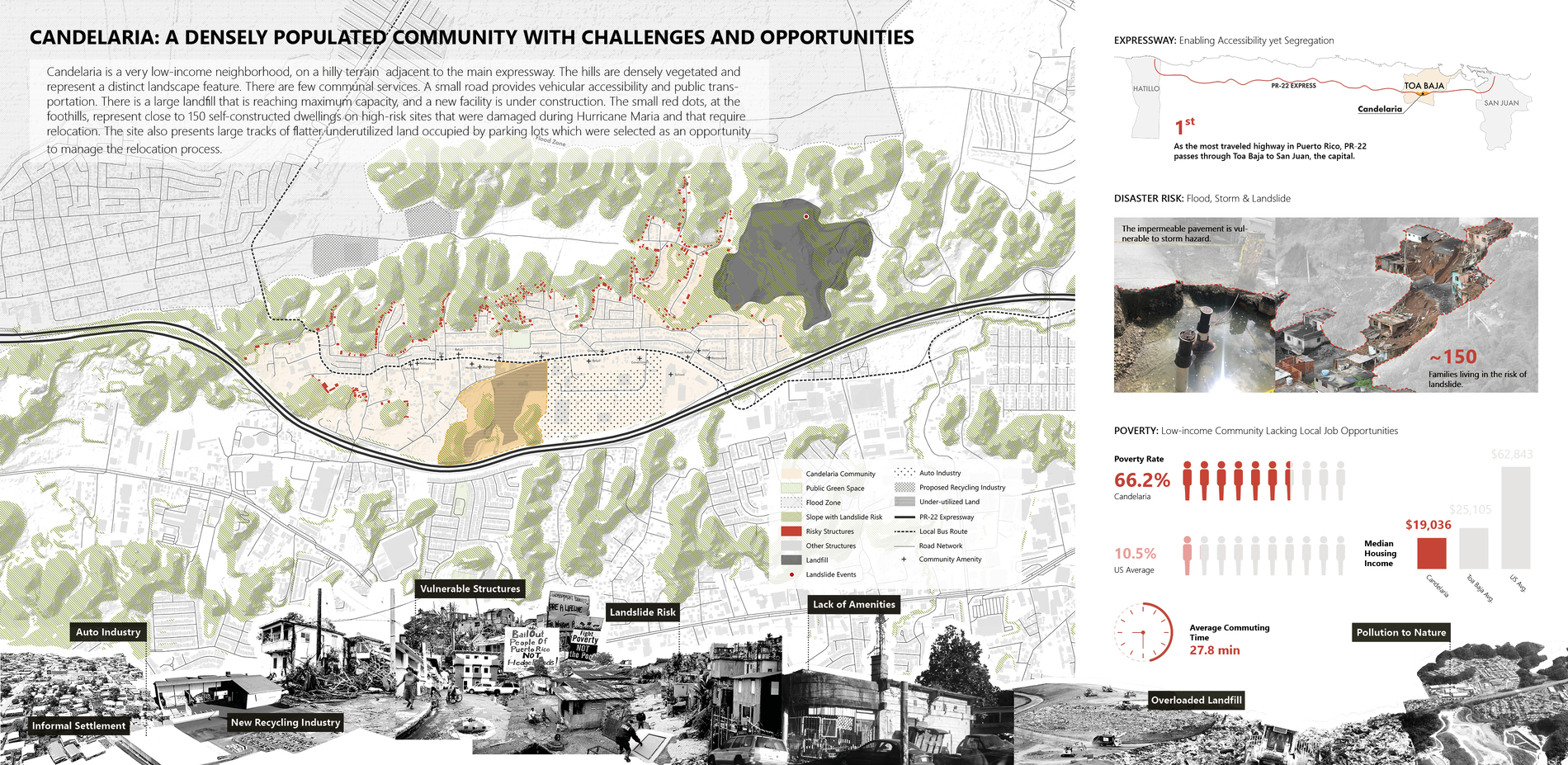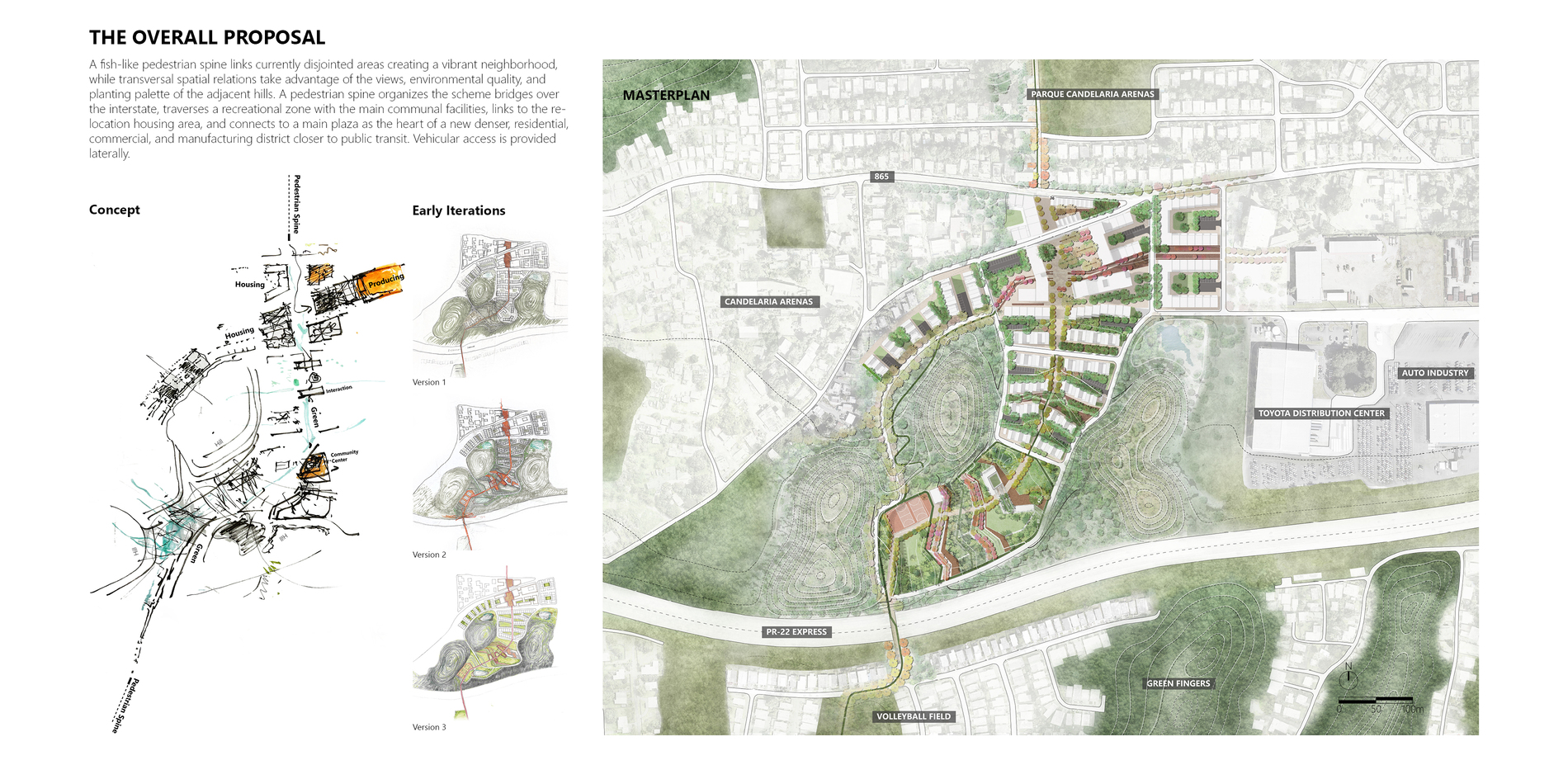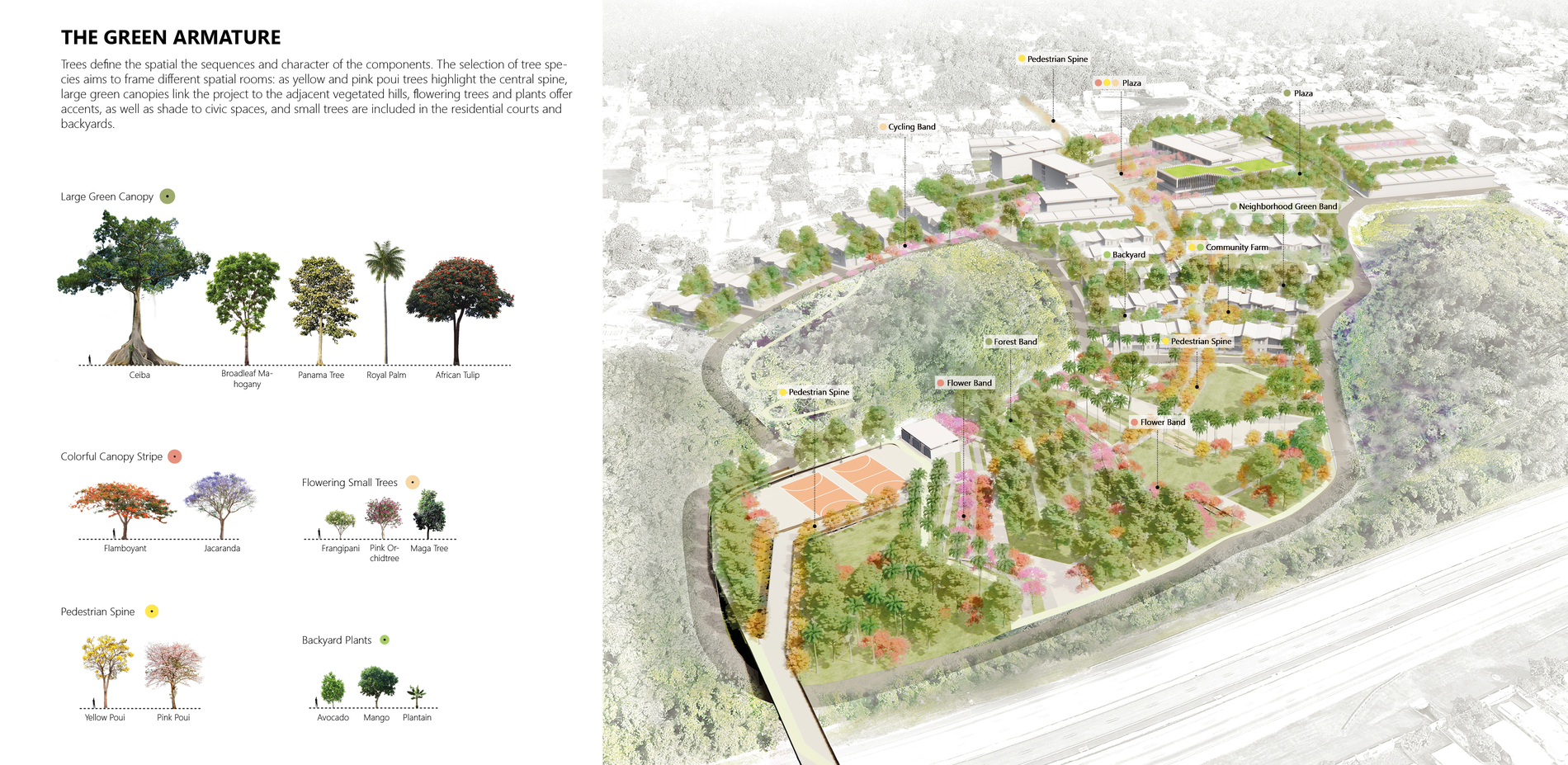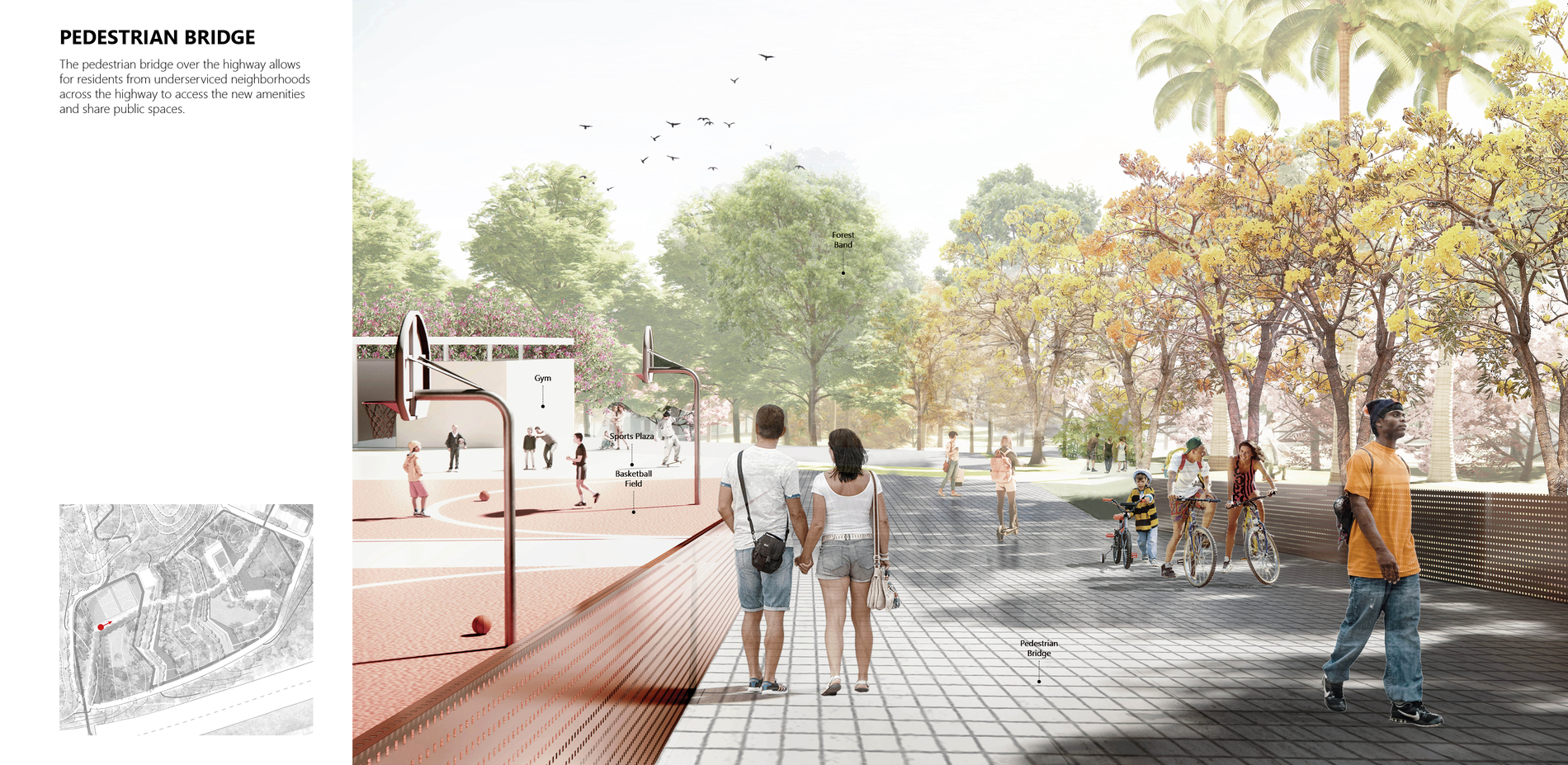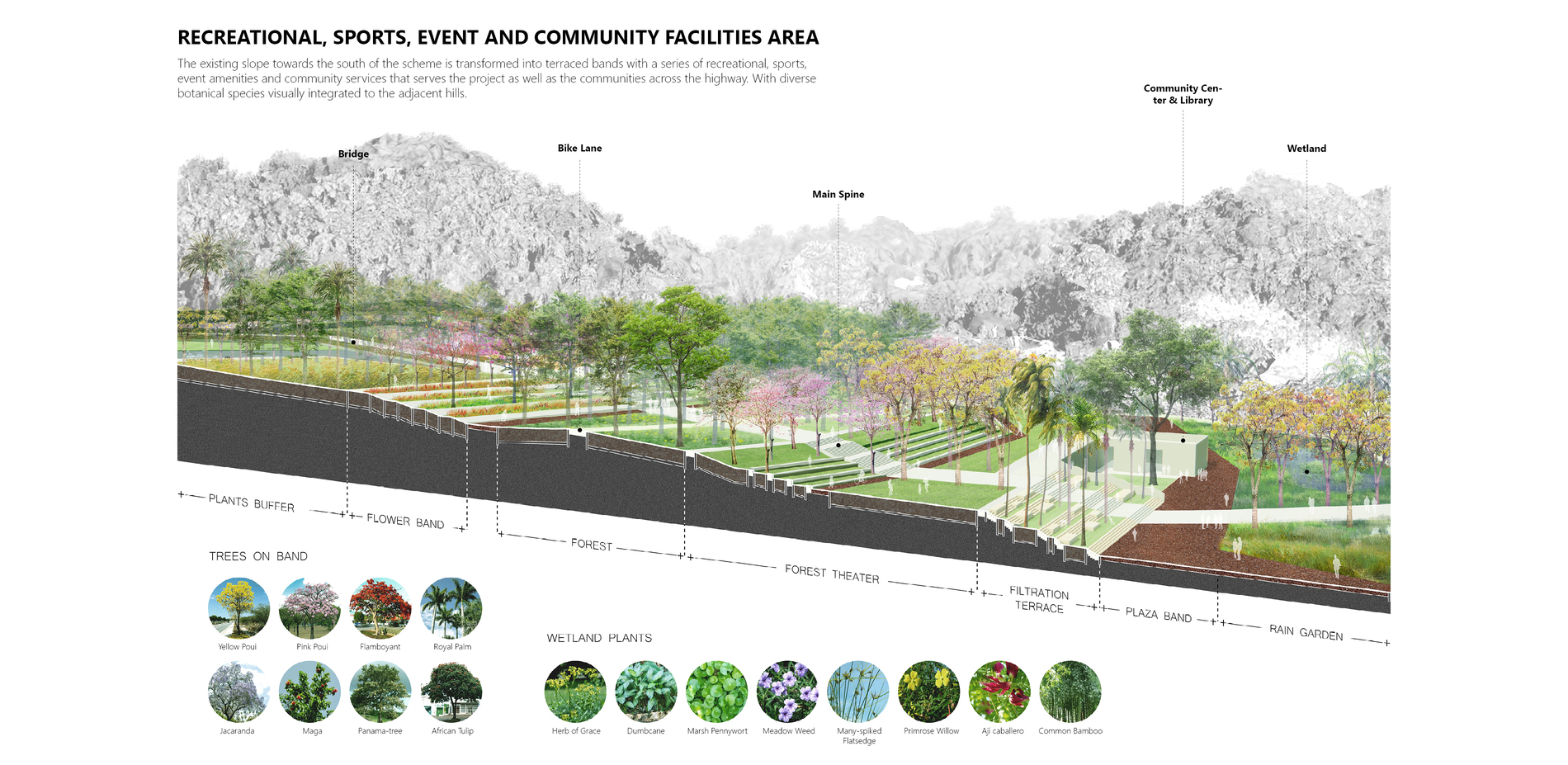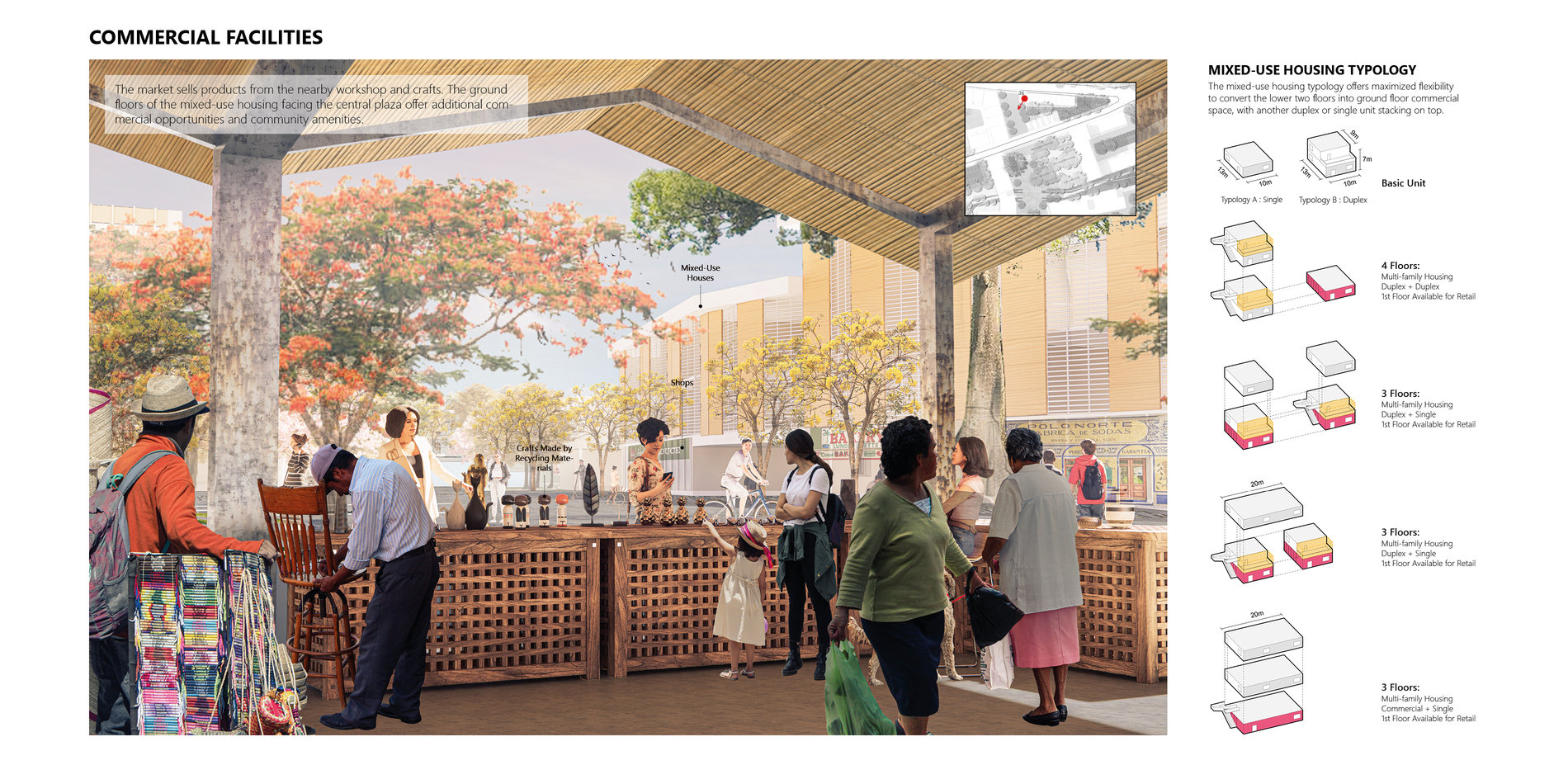A New Central District and Balanced Community
Honor Award
Residential Design
Toa Baja, Puerto Rico, United States
Yihan Huang;
Zhimin Ma;
Linda Ge;
Ruoxin Jia;
Faculty Advisors:
David Gouverneur;
Judy Venonsky, ASLA;
University of Pennsylvania
The proposal to convert a large surface parking area into a densely populated and economically diverse town center in a hurricane-stricken part of Puerto Rico is as practical and logical as it is visionary. It is easy to see how the design's focus on social equity and placemaking would create a beautiful and healthy community.
- 2022 Awards Jury
Project Statement
In 2017, Hurricane Maria brought enormous damage and losses to most urban areas of Puerto Rico. Houses in the Candelaria, neighborhoods of Toa Baja, and part of the San Juan Metropolitan Area, were heavily affected by landslides. The lowest income and self-constructed dwellings located on steep terrain became extremely vulnerable to future natural disasters since then, most of which lack maintenance after emergent repairs. Candelaria is currently facing inefficient industrial single land use, as well as a lack of community services and public spaces, which has finally exacerbated social instability.
When there are large tracks on underutilized land, we envision this urban void to serve as a unique opportunity to create a new town center. In the end, the project provides an alternative to suburban patterns adopted in PR after it became part of the USA, stitching disjointed urban patches with the natural environment, relocating local families at risk, upgrading existing industries, and creating new opportunities for economic growth and community amenities.
Project Narrative
1. Context
In 2017, Hurricane Maria brought enormous damage and losses to most urban areas of Puerto Rico and Toa Baja was one of the hardest-hit towns then. More than 10 inches of rainfall in 48 hours not only caused the Toa Baja River to flood the northern plains of the town but also led to severe landslides which destroyed settlements at the foot of the hills. Houses in the Candelaria, neighborhoods of Toa Baja, and part of the San Juan Metropolitan Area, were heavily affected by landslides, with about 150 families whose houses were severely damaged or even destroyed. The lowest income and self-constructed dwellings located on steep terrain became extremely vulnerable to natural disasters. Despite of the maintenance and reconstruction provided by the federal government and local authorities, most of which lack maintenance after emergent repairs. As a result, Candelaria is still facing the issue of poor infrastructure, a lack of community services, and public spaces. In addition, the country’s main highway also leads to the fragmentation of urban components and there still are large tracks on underutilized land.
2. The Site
Despite the serious flooding issues in Toa Baja, most part of the Candelaria locates on a higher elevation, becomes one of the few communities free from flooding hazards. Situated in-between the hills, Candelaria enjoys unique spatial characters shaped by the natural barriers. The site, currently a large parking lot adjacent to the expressway, provides the potential for a new town center with relocation housing. Next to several factories and warehouses of varied sizes, the parking lot sits in between two small hills. The existing retention pond highlights the water feature on-site and helps collect water when it floods. The site also experiences drastic topographic changes, consisting of a 15-meter height difference from south to north.
The neighborhood, though highly accessible by car, is physically cut off from the local communities in the south by the PR-22 Expressway, the main highway connecting Toa Baja and San Juan from east to west. Candelaria is thus expanding in a linear way from east to west, failing to form a public town center for social gatherings even when auto-related light industries occupied here and brought hustles and bustles.
However, Candelaria is regarded as a low-income neighborhood with only one-third of the national average median household income and a more than 60% poverty rate. Moreover, apart from the fact that Candelaria does not have sufficient amenities, local residents also need to travel far for job opportunities.
Right at the edge of the neighborhood, a landfill poses long-lasting threats to Candelaria residents, as it spreads a poisonous smell and soil pollution. More pressingly, the landfill has already reached its capacity, but the local government thinks that it’s too expensive to close it. A newly proposed recycling center by the local government will help incentivize the upgrading and transformation of the local industry, which is currently heavily concentrated on the auto industry, into a more sustainable one.
3. Strategies
This urban void appears to be an opportunity to relocate families from risk zones, create a vibrant district, stitch neighborhoods with the natural settings, as well as to provide open spaces and urban amenities when fostering the local economic growth.
The overall framework highlights three perspectives.
First, Grading the sloping terrain to create terraces accommodating the different uses, managing water, enhancing the relations between the site and the natural setting, and providing diverse spatial relations, and experiential conditions.
Second, a pedestrian spine with bike lanes runs across the expressway, while linking its different components: a) Sport, leisure, and community service areas, b) A relocation housing neighborhood, and c) A town center with denser mixed-use developments, commercial facilities, a market, a manufacturing/training center, serving the broader Candelaria district, and accessible by public transportation.
Third, -A botanical framework with local species providing habitat connectivity, spatial orientation, shade, community gardens, and identity and diversity.
The strategy consists of three systems. The green and blue armature system highlight continuous expanded connections and interaction with the hills and other existing natural landscapes; the public space and community amenities system highlights a series of newly created public spaces associated with proposed facilities such as community centers, markets, bus stations, mixed-use development, etc; the relocation and mixed-use housing system features three housing typologies and encourages self-construction and maintenance, interacting with various public and private space relationships.
The design is also catering to the existing topography, steeper slope in the south for the new park, and gradually flattened land in the north for the relocation community. Part of the topography is modified to create a more smooth and efficient pedestrian and vehicular circulation as well as to handle water management. The existing low points, such as ponds and the foot of the hills, are embedded with water management approaches, such as community farms, rain gardens, as well as permeable surfaces, etc. Planting strategy with local vegetation, ranging from large green canopy to backyard plants, not only help to shape a continuous compelling landscape and public realm but define a series of unique spatial sequence.
4. Conclusion and Long-Term Vision
As a pilot project, the new Candelaria town center with relocation housing will serve as a prototype for the Toa Baja government to explore relocation alternatives utilizing large vacant lots when dealing with climate change impacts.
The pilot project consists of three phases. The first phase will feature planting the trees along spines as the beginning, using landscape to define the potential built environment. The relocation of housing in the middle part along with the community band of the park, happened at the same time, to start creating a sense of community. The second phase features building up the central plaza in order to create this new public centrality, starting to introduce the combination of recycling and manufacturing industries. The rest of the community park will also be finished during this phase. In the third phase, the relocation housing will be expanded and the technical school and manufacturing center will be completed, which will welcome more people to come and use this new town center.
Plant List:
- Ceiba
- Broadleaf Mahogany
- Panama Tree
- Royal Palm
- African Tulip
- Flamboyant
- Jacaranda
- Frangipani
- Pink Orchidtree
- Maga Tree
- Yellow Poui
- Pink Poui
- Avocado
- Mango
- Plantain

